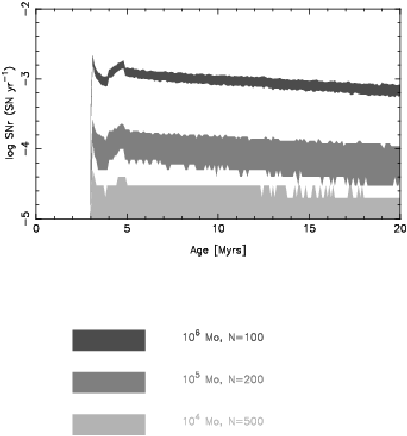Here you can access to the output file and parabolic subroutine (click here to take it) presented in this paper:

The data file contains:
- Age in Myr
- SNr: SN rate, the number of SN year-1 Mo-1
- N(SNr): Neff(SN rate), relative dispersion on the number of SN rate in (105 year)-1 Mo-1
- Ek: Ek, Kinetic energy released by the burts into the ISM, in erg s-1 Mo-1. It has been computed from predefined tables (method b.2 described in the paper)
- N(Ek): Neff(Ek), relative dispersion on the Kinetic energy released by the burts in Mo-1.
- 12C: 12C, cumulative amount of 12C in Mo-1. Also computed by method b.2 described in the paper.
- N(C): Neff(12C), relative dispersion in the cumulative amount of 12C in Mo-1.
- 14N: 14N, Cumulative amount of 14N in Mo-1.
- N(N): Neff(14N), relative dispersion in the cumulative amount of 14N in Mo-1.
- N/C: 14N/12C ratio
- N(N/C): Neff(14N/12C), relative dispersion in the 14N/12C ratio in Mo-1.
- pho(N,C): Correlation coefficient between 14N and 12C.
For use it you must multiply the output by the ammount of gas transformed in stars, and you must take into account that:
- The models assume a Salpeter IMF slope in the mass range 2 - 120 Mo, so the multiply factor is the ammount of gas transformed in stars in this mass range.
- The output has been normalized to The amount of gas transformed in stars since the onset of the burst , Mtot
The sigma2(A) value for a given amount of mass transformed into star for any cuantity Ais obtained using:
with Neff*(A) = Neff(A) x Mtot
Neff must be always denormalized!!
See paper CL II of this series for obtain the corresponding confidence levels.
| | Justicia, no venganza Justice, not revenge | We thanks to the LAEFF for the space for host this server | |
Miguel Cerviño 2001